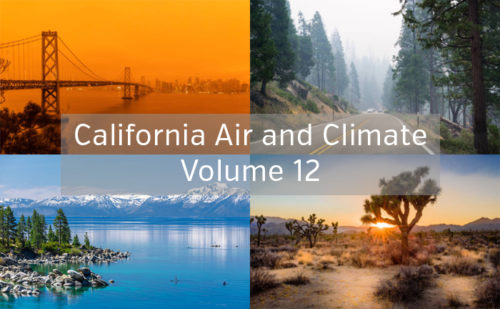California Air and Climate: CARB Targets Railyard and At Berth Vessel Emissions; San Joaquin Valley APCD to Require Additional NOx Reductions from Engines, Boilers, Process Heaters and Steam Generators
January 2020
California Air and Climate, Vol. 12
CARB Holds Public Workshops to Develop Measures to Reduce Railyard and Locomotive Emissions
The California Air Resources Board (CARB) recently held a series of public meetings and workshops to develop concepts to reduce emissions from locomotives and railyards. Designed to complement actions taken by the South Coast Air Quality Management District (SCAQMD), the draft concepts are intended to reduce criteria air pollutants and greenhouse gas emissions (GHG) from active or idling locomotives, maintenance activities, as well as emissions from other equipment such as cargo handling trucks and forklifts at railyards. Specific concepts include establishing a locomotive emissions reduction spending account that would redirect locomotive usage charges towards the funding of cleaner locomotives, and establishing an in-use locomotive remanufacture limit. Currently, there is no limit on how many times a railroad can remanufacture a locomotive and return it to use. However, CARB’s draft concept would ban any locomotive from being used in California that has been remanufactured more than once. CARB anticipates holding additional public meetings and workshops regarding CARB’s draft concepts later this year.
For additional information, please click here.
CARB Reviewing Public Comments on Regulations to Reduce Emissions from At Berth Ocean-Going Vessels
On December 5, 2019, CARB held a public hearing on CARB’s proposed regulations to further reduce air pollution from ocean-going vessels that are “at berth” or docked in California ports and marine terminals. As we previously reported, under existing regulations, certain container vessels, reefer vessels, and passenger cruise vessels that visit specified California ports are subject to certain restrictions aimed at reducing emissions from diesel auxiliary engines. Fleet operators may comply by reducing onboard power or auxiliary engine usage according to mandated percentages in relation to the number of annual visits within the fleet. Alternatively, fleet operators may reduce vessel emissions by a mandated percentage below the fleet’s baseline emissions. According to CARB, the Board’s proposed regulations are designed to achieve added public health and air quality benefits by further reducing oxides of nitrogen (NOx), diesel particulate matter (DPM), particulate matter 2.5 (PM2.5), reactive organic gas (ROG), GHG emissions, and black carbon beyond existing regulations. CARB’s proposed regulation accomplishes this by introducing emission control requirements to additional ports and terminals, including marine terminals that operate independently from a port or port authority, and adding other vessels such as ro-ro (roll-on/roll-off) vessels that carry cargo such as cars and trucks, as well as tankers, which are not covered under existing regulations. The public comment period on CARB’s draft regulations ended on December 9, 2019. CARB plans to hold another public hearing on the public comments CARB received on a future date.
The Initial Statement of Reasons and proposed regulations are available on CARB’s website here.
San Joaquin Valley APCD to Require Additional NOx Emission Reductions from Internal Combustion Engines, Boilers, Process Heaters, and Steam Generators
At December 5, 2019 scoping meetings, the San Joaquin Valley Air Pollution Control District (SJVAPCD) announced plans to amend its rules to require additional NOx emission reductions from two categories of stationary sources: 1) internal combustion engines rated at 25 horsepower and greater (Rule 4702) and 2) boilers, process heaters and steam generators with a total rated heat input of greater than 5.0 MMBtu per hour (Rules 4306 and 4320). These amendments will affect units at a broad range of facilities including oil and gas; manufacturing; agriculture and food processing; electrical generation; and livestock and dairy operations, as well as large institutions such as schools and hospitals. Although NOx emissions from these sources has already been reduced by as much as 96%, the District is required to seek additional emission reductions under its 2018 PM2.5 Plan (NOx is a predominant pollutant in the formation of PM2.5 in the Valley).
Internal Combustion Engines – For internal combustion engines at non-agricultural operations, SJVAPCD plans to reduce NOx emissions to the extent that such controls are technologically achievable and economically feasible (from 11 ppm to as low as 5 ppm). For agricultural engines, typically ground water pumps, SJVAPCD plans to drive replacement of older engines with electric pumps or Tier 4 engines through incentive programs.
Boilers, Process Heaters and Steam Generators – SJVAPCD indicates that it will consider lowering NOx limits from the current range of 5 to 12 ppm to as low as 2 to 3.5 ppm, depending on category and use of the units. Because some of these limits will require adoption of controls more expensive than what is considered Reasonably Available Control Technology (RACT), SJVAPCD plans to continue to allow the use of the Advanced Emission Reduction Option, which provides operators the option to pay emission fees in lieu of installing expensive controls.
SJVAPCD plans to adopt these rule amendments in 2020 with implementation dates starting in 2024. Additional information is posted here.

